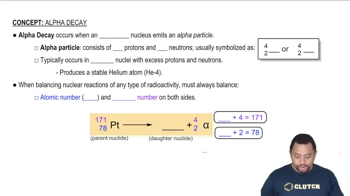Here are the essential concepts you must grasp in order to answer the question correctly.
Nuclear Decay
Nuclear decay is the process by which an unstable atomic nucleus loses energy by emitting radiation. This can occur through various modes, including alpha decay, beta decay, and gamma decay. Each mode involves the transformation of the nucleus, resulting in the emission of particles or electromagnetic radiation, leading to the formation of a different nuclide.
Recommended video:
Nuclear Equations
Nuclear equations represent the changes that occur during nuclear reactions, including decay processes. They typically show the initial nuclide, the emitted particles, and the resulting nuclide. For example, in beta decay, a neutron is converted into a proton, and an electron (beta particle) is emitted, which can be represented in a balanced equation format.
Recommended video:
Isotopes and Stability
Isotopes are variants of a chemical element that have the same number of protons but different numbers of neutrons. The stability of an isotope depends on the ratio of neutrons to protons; an unstable isotope, like Ru-114, may undergo decay to achieve a more stable configuration. Understanding the stability of isotopes is crucial for predicting their decay modes and writing accurate nuclear equations.
Recommended video:




